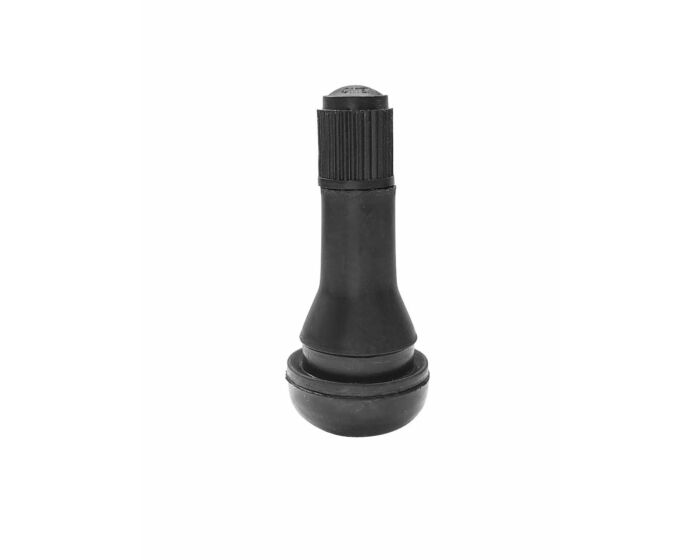We use cookies to make your experience better. To comply with the new e-Privacy directive, we need to ask for your consent to set the cookies. Learn more.
TR 413 V2.03.1 TUV
PromoProduct category: Automotive valves
Price for: 100 per box
The TR 413 rubber valve is a high-quality valve for tubeless passenger car tires designed for both aluminum and steel rims.
- Details
-
The TR 413 rubber valve is a top-quality valve for tubeless passenger car tires designed for both aluminum and steel rims. Our rubber valves are made from a rubber compound containing synthetic rubber – EPDM. This makes them resistant to ozone, UV radiation, and weather conditions. To ensure product quality, every delivery undergoes quality testing. The TR 413 valve guarantees safety in everyday use.
Advantages:
- Made from rubber with synthetic rubber EPDM
- Resistant to ozone and weather conditions
- UV-resistant
- Ensures safety in everyday use
- Maximum pressure: 4.5 bar
- Valves are supplied with an insert and cap
Bulk packaging – 100 pieces.
- Technical data
-
- Material: natural rubber + EPDM
- Stem: brass
- Core: brass
- Dedicated for: Passenger cars & LCV
- Maximum inflating pressure: 4.50 bar
- Rim hole: 11,3 mm
- TR: 413
- ETRTO: V02.03.1
- Length: 43 mm
- Packaging units: 100 pcs
- Warranty
-
Storage, Usage, and Installation Requirements for TR Snap-in Valves
Application:
- Valves are intended for tubeless tires of passenger cars and trailers.
Pressure Range:
- The maximum working pressure is 4.5 bar (65 psi).
Maximum Allowable Speed:
- The permissible maximum speed for TR valves is 210 km/h (130 mph).
- For higher speeds (tire indexes V, W, Y, ZR), for safety reasons, metal valves should be used.
Requirements for Rim:
- Rim shape: Round. The rim must not be oval.
- Valve seating diameter: 11.3 mm with a tolerance of -0/+0.4 mm.
- Rim hole: Must be free from burrs, damages, and comply with ETRTO regulations.
- Rim thickness: Minimum required thickness is 1.8 mm; maximum required thickness is 4 mm.
Proper Storage Requirements:
- Valves must be stored in a cool and dark place.
- Valves must be protected from sunlight and ozone.
- Valves should not be stored in the same room as electrical equipment or chemicals.
- Prolonged storage should be avoided. The production date and maximum assembly date are provided on the packaging (if not, it should be assumed that the maximum assembly date is 12 months from the valve purchase date from TIP-TOPOL).
Improper Storage Consequences:
- Acceleration of the natural aging process of rubber may occur.
- Decrease in rubber elasticity, leading to potential cracks during installation.
Cap Installation:
- To protect the valve from dirt and corrosion, the cap should be securely installed.
Recommendations for Valve Replacement:
- Due to changes in rubber structure, corrosion, and material fatigue related to speed, valves should be replaced with every wheel or tire change. The recommended period of use for the valve is a maximum of 12 months from the assembly date.
Installation Guidelines:
- Proper lubrication of the valve is essential during installation.
- Do not install a valve with existing cracks.
- Avoid pulling the valve at an angle during installation.
- Safety
-
- Responsible Producer:
-
TIPTOPOL SP. Z O.O.
ul. Kostrzyńska 33
62-010 Pobiedziska
Poland
sklep@tiptopol.pl
+48618152200
Mechanical risks
The product has movable parts that can cause a variety of mechanical hazards during operation, which can lead to serious injuries.
Crushing and crushing: There is a risk that the moving parts of the product will crush or crush the body. It can lead to serious injury or permanent injury.
Cuts and punctures: Cuts, cuts, and even deeper injuries can occur if the user comes into contact with sharp edges or product components.
Impact and Fall Injuries: These can occur when objects fall over and fall from a height or are moved in an improper and dangerous manner. This can cause serious injuries, including broken bones and head injuries.
Trapping: If a body part becomes trapped between moving parts, it can lead to serious injury and loss of limbs.
Vibration: Exposure to prolonged vibration while using the device can damage muscles and nerves. This can lead to vibration syndrome, causing pain and dysfunction in the limbs.
To minimise these risks, it is recommended to use appropriate personal protective equipment, regularly inspect and maintain the equipment, and follow all manufacturer's recommendations for safe use and health and safety (Occupational Health and Safety) regulations.
Environmental risks
A variety of environmental hazards can occur during the use and disposal of products, which can lead to serious consequences.
Environmental pollution: Products, especially those containing chemicals or plastic, can contribute to soil, water, and air pollution. This can lead to the degradation of ecosystems, groundwater and surface water pollution, and negative impacts on human and animal health.
Improper disposal of products: Improper waste management can lead to the uncontrolled spread of toxins and contaminants. This can result in severe environmental pollution, risks to public health, and the loss of valuable natural resources through a lack of recycling.
Electronic waste (e-waste): Electronic products, when not properly disposed of, can become a source of e-waste containing harmful chemicals and heavy metals. This can lead to soil and water contamination, as well as pose a risk to human and animal health.
To minimise environmental risks, it is recommended to manage waste appropriately, including segregation and compliance with environmental regulations.


